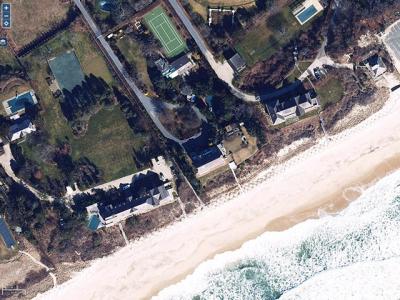Village Z.B.A. Pares Back Lily Pond Lane Proposal

The owners of an oceanfront property on Lily Pond Lane, who are seeking permission to tear down a house in a coastal erosion hazard area and construct a new, larger one, presented a revised and pared-down building plan to the East Hampton Village Zoning Board of Appeals on Friday. At the initial hearing for the application on Jan. 11, the owners, Helene and Norman Stark, had sought 54 variances.
The Starks’ existing house, at 33 Lily Pond Lane, is approximately 4,600 square feet; the property also has a pool and a patio that overlooks the beach, as well as a tennis court, a tennis house, and a koi pond. The Starks want to replace the house with one that measures more than 7,000 square feet, with attached decking. Although the house would be sited farther landward, much of the building plan — including the installation of a swimming pool and hot tub, a patio, retaining walls, staircases, and dry wells — would necessitate variances from the section of the code that is meant to preserve ocean dunes. The code requires a 150-foot setback from the southerly edge of beach grass, and a 100-foot setback from the 15-foot contour line of the dune. The legally pre-existing coverage for the property (including an earlier variance) is about 17,000 square feet.
Richard Warren, an environmental consultant from InterScience Research Associates who is advising the owners, presented the new plan to the board, and said it was designed to eliminate a significant number of requested variances.
The application, he said, has two main goals: to bring the property into conformity with the code, and to build a new home.
Addressing the former, he said, the owners now intend to remove certain existing features (including the koi pond, to eliminate five variances), as well as shelving a number of previously suggested improvements that would have pushed the permitted coverage over the top (these include a deck addition, a trellis, part of a brick patio, a walkway, and a play set). The tennis court, which encroaches on a setback, he said, will be reduced by 10 feet.
The owners are still seeking variances to legalize a 77-square-foot addition to the existing residence, as well as a 100-square-foot storage shed, a 303-square-foot addition to a tennis house, steps built into the landscape on the east side of the property, and an existing generator.
At the Jan. 11 hearing, Mr. Warren said that the Z.B.A. in 2005 had granted the Starks permission to expand the existing house. On Friday, he said the coverage in the newly revised application was equal to the amount allowed by the board in 2005.
As for the the new house, Mr. Warren said the plan calls for siting it and the swimming pool even farther landward than first proposed. “We took three feet off the house, and two feet off the swimming pool,” he said. “We moved everything back five feet.”
The placement of the house would still lie within the coastal erosion hazard area, he said, but it would provide the owners with a view of the ocean, and allow for a “graceful” rather than “cramp-ed” development of the property.
“The plan is reasonable,” he said. He also cited analysis from experts on coastal erosion such as Henry Bokuniewicz, a professor in the school of marine and atmospheric sciences at Stony Brook University, and Dr. Lee Weishar, a senior scientist and coastal engineer at the Woods Hole Group, an environmental services organization headquartered in Massachusetts, who determined that construction on the property would not affect the dune or the shoreline.
After Mr. Warren’s presentation, Brian Matthews, a lawyer representing two of the Starks’ neighbors, said that his clients objected to the application because of the size of the house and its placement seaward of the coastal erosion line.
Jeff Bragman, a lawyer and town board member who was representing Mortimer Zuckerman, the real estate developer and media mogul who is another neighbor, said he would consider the latest plan and return at a future date to offer his opinion.
Since board members, including Lys Marigold, the chairwoman, had been presented with the plan for the first time at the meeting, they also decided to study the details and weigh in later. The hearing was adjourned to March 8.
Also on Friday, the board passed a resolution, and announced three decisions on earlier applications.
The resolution approved a settlement of the lawsuit between the village and Molly Zweig, a resident of 11 West End Road who had constructed a revetment in front of her house in 2013 after receiving required permitting from the New York State Department of Environmental Conservation and the zoning board. The East Hampton Town Trustees had filed a court challenge to the Z.B.A.’s decision, seeking to stop the construction, and litigation between the parties had been ongoing ever since. (More details appear elsewhere in this issue.)
The Maidstone Club was granted a wetlands permit and special permit to install various drainage structures within wetland setbacks, on the condition that wire-backed silt fencing be installed during construction between the disturbed area and the wetlands.
Joe Quinn, the owner of 11 Talmage Lane, was granted permission to construct a 591-square-foot detached garage some 7.3 feet from the side lot line, where the required setback is 15 feet, and to install swimming pool equipment 21 feet from the side lot line, where a 30-foot setback is required.
Judith H. Hope, the owner of 26 Dunemere Lane, was granted area variances to construct a swimming pool 20.2 feet from the rear lot line, and 27 feet from the side lot line, where the required setbacks are 30 feet, on the condition that a six-foot hedge and six-foot stockade fence be maintained along the property’s northerly boundary.
